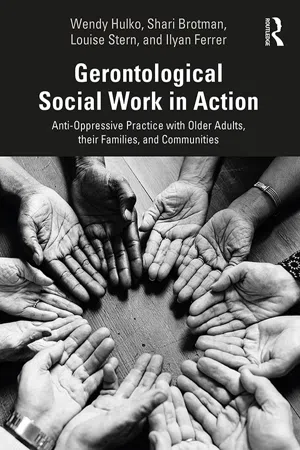
Gerontological Social Work in Action
Anti-Oppressive Practice with Older Adults, their Families, and Communities
- 276 pages
- English
- ePUB (mobile friendly)
- Available on iOS & Android
Gerontological Social Work in Action
Anti-Oppressive Practice with Older Adults, their Families, and Communities
About This Book
Gerontological Social Work in Action introduces "anti-oppression gerontology" (AOG), a critical approach to social work with older adults, their families, and communities. AOG principles are applied to direct and indirect practice and a range of topics of relevance to social work practice in the context of a rapidly aging and increasingly diverse world.
Weaving together stories from diverse older adults, theories, research, and practical tools, this unique textbook prompts social workers to think differently and push back against oppressive forces. It pays attention to issues, realities, and contexts that are largely absent in social work education and gerontological practice, including important developments in our understanding of age/ism; theories of aging and social work; sites and sectors of health and social care; managing risk and frailty; moral, ethical and legal questions about aging including medical assistance in dying; caregiving; dementia and citizenship; trauma; and much more.
This textbook should be considered essential reading for social work students new to or seeking to specialize in aging, as well as those interested in the application of anti-oppressive principles to working with older adults and researching later life.
Frequently asked questions
Information
Part 1
Shifting our lens on gerontological social work
Chapter 1
Age/ism
Age as a category of difference
Questions to consider as you read this chapter
- Given the diversity of experiences of aging, how do we know when someone is considered “old”?
- What perceptions do we have of someone who is older?
- How do identity categories such as age, race, and gender distinguish people?
- What is ageism and age discrimination?
- How do we – as social workers – challenge dominant perceptions of aging and ageism?
- What role can older people’s counter-stories play in this process?
- The global population of people aged 60+ years numbered 962 million in 2017. This is more than double the size recorded in 1980. The number of older people 60+ years is projected to double to nearly 2.1 billion by 2050.
- In many Global North and Global South societies, older persons are expected to outnumber children under age ten (1.41 billion versus 1.35 billion) by 2030. The number of persons 80+ years is projected to rise from 137 million to 425 million by 2050.
- Two thirds of the world’s older persons live in the Global South, and their numbers and growth are outpacing the number of older people in Global North societies. The United Nations projects eight out of ten of the world’s older people will be living in the Global South by 2050.
- The United Nations (2017) noted significant differences in the rates of intergenerational family cohabitation between Global North and Global South societies. For example, more than half of persons aged 60+ co-resided with a child in Asia, Africa, and Latin America and the Caribbean. However, only about 20% of older people lived with their children in Europe and North America. In general, older women are more likely than older men to live alone.
- Media Snapshot 1: “The older they get, the more they cost” (The Economist as cited in Martin, Williams, & O’Neill, 2004).
- Media Snapshot 2: “Given that they all agree that a demographic ‘pension time-bomb’ is ticking, Europe’s policy makers have done remarkably little to diffuse it” (The Economist as cited in Martin et al., 2004)
- Media Snapshot 3: “Far too many people, including health professionals and policy-makers, believe that older people are hopeless and burdensome, so they make little effort” (Globe and Mail as cited in Fraser, Kenyon, Lagace, Wittich, & Southall, 2016).
- Media Snapshot 4: “There is much angst these days about the impact of the aging population on health care utilization and spending” (Globe and Mail as cited in Fraser et al., 2016).
The objectives of this chapter are to
- Understand shifts within the aging population in Canada and across the globe;
- Acknowledge and discuss how age is a category of difference and ageism is a form of oppression;
- Understand the life course and intersectionality and their interrelationship; and
- Consider the ideologies that shape and structure expectations of aging.
Age as a category of difference and distinguishing older people as “old”
- Chronology: How old are you in years?
- Description: What words describe how old you are?
- Relations: How do other people affect your experience of aging?
- Body: How are changes in your body affecting your sense of aging?
- Pressures: How do social expectations and institutional regulations regarding age affect your experience of aging?
- Biography: How do you view your past and your future?
Chronological, functional age and life stages
Table of contents
- Half Title
- Title Page
- Copyright Page
- Dedication
- Table of Contents
- List of tables and figures
- Preface
- Acknowledgements
- Introduction
- PART 1: Shifting our lens on gerontological social work
- PART 2: Doing AOP social work with older adults
- PART 3: Revisioning gerontological social work
- Concluding thoughts
- Index